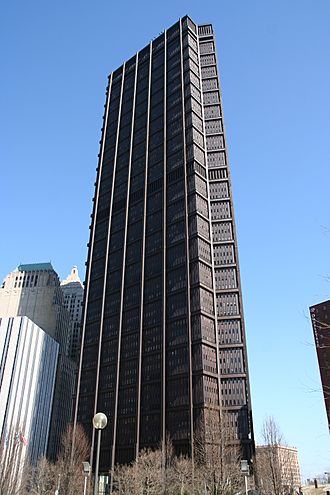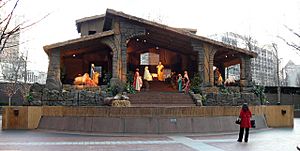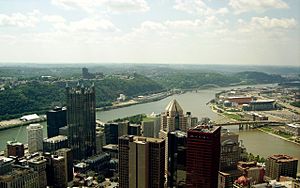U.S. Steel Tower facts for kids
Quick facts for kids U.S. Steel Tower |
|
|---|---|

The tower before 2008 signage
|
|
| Former names | USX Tower (1988–2001) |
| General information | |
| Type | Commercial offices (Authorized commercial offices) |
| Location | 600 Grant Street Pittsburgh, Pennsylvania |
| Coordinates | 40°26′29″N 79°59′41″W / 40.4413°N 79.9947°W |
| Construction started | March 15, 1967 |
| Completed | September 30, 1971 |
| Cost | $50 million+ ($451 million+ today) |
| Owner | The 601W Companies |
| Management | Winthrop Management |
| Height | |
| Roof | 256.34 m (841.0 ft) |
| Technical details | |
| Floor count | 64 |
| Floor area | 2,336,253 sq ft (217,045.0 m2) |
| Lifts/elevators | 54 - six banks of eight passenger elevators, four freight and two private elevators |
| Design and construction | |
| Architect | Harrison, Abramovitz & Abbe |
| Structural engineer | Leslie E. Robertson Associates |
| Main contractor | Turner Construction |
The U.S. Steel Tower is a very tall building in downtown Pittsburgh, Pennsylvania. People also call it the Steel Building or USX Tower. It has 64 floors and stands at 600 Grant Street.
This skyscraper is 841 ft (256 m) tall. It is the tallest building in Pittsburgh. It is also the fifth-tallest in Pennsylvania. The building officially opened on September 30, 1971.
The tower was first named the U.S. Steel Tower. In 1988, its name changed to USX Tower. Then, in January 2002, it went back to being the U.S. Steel Tower. This change happened to match the new name of the company, U.S. Steel. Even though U.S. Steel no longer owns the building, it is still one of the biggest companies renting space there.
Contents
History of the U.S. Steel Tower
Before 1970, the Gulf Tower was the tallest building in Pittsburgh. It had 44 stories. When the U.S. Steel Tower was being planned, the company thought about making it the tallest building in the world.
However, they decided on 840 ft (260 m) tall. This made it the tallest building outside of New York and Chicago at the time. Later, other new buildings in the United States became even taller.
Building Design and Materials
The U.S. Steel Tower used over 44,000 tons of steel to build. Each floor has almost an acre of office space. The building has a special triangular shape with corners that go inward.
It was also the first building to use columns filled with liquid for fire safety. U.S. Steel wanted to show off a new type of steel called Cor-ten steel. This steel resists rust and bad weather. It forms a dark brown layer that protects it. This means it does not need painting.
When the Cor-Ten steel first weathered, it stained the sidewalks and nearby buildings. U.S. Steel cleaned up the area after the steel finished changing color. But the sidewalks still have a slight rusty look. The Cor-Ten steel for the building was made at the former Homestead Steel Works.
Past Tenants and Events
Rockwell International used to have its main office in the tower. They had a large model of the NASA Space Shuttle in the lobby. Rockwell moved its headquarters in 1988.
In May 1986, two men jumped off the roof with parachutes. The Pittsburgh Police arrested them nearby.
Today, the biggest company renting space in the building is UPMC. They use 500,000 square feet (46,000 m2) of office space. In 2008, UPMC added signs that light up with "UPMC" on top of the tower. Some people who helped build the tower did not like this change.
U.S. Steel's Plans to Move
On November 24, 2014, U.S. Steel said it would leave the U.S. Steel Tower. They planned to build new offices near the old Civic Arena.
But in November 2015, U.S. Steel changed its mind. They announced they would stay in the U.S. Steel Tower until at least 2017.
Special Features of the Tower
Water-Filled Columns for Fire Safety
Usually, steel in buildings needs to be covered to protect it from fire. But the U.S. Steel Tower used a special method. Its 18 main columns are hollow and filled with a mix of water, antifreeze, and rust protector. This old idea from the 1800s helped meet fire safety rules.
LEED Certification for Green Building
In 2019, the building earned a LEED Silver Certification. LEED stands for Leadership in Energy and Environmental Design. This means the U.S. Steel Tower is recognized for being environmentally friendly in how it operates. It is one of the largest office buildings in the world with this certification. Many offices inside the tower have also earned their own LEED certifications.
Reliable Building Systems
The U.S. Steel Tower has many backup systems. This helps the building avoid unexpected shutdowns. For example, it has two water pipes from different streets. If one fails, the other automatically takes over.
It also has four backup water pumps. Any one of these can supply water for the whole building. The tower also gets electricity from four different sources. This means it has a very reliable power supply.
Finally, the building has backup heating and cooling systems. It has two boilers and two chillers. The heating boilers can use natural gas or fuel oil. If one fuel runs out, workers can switch to the other quickly.
UPMC Signage on Top
The University of Pittsburgh Medical Center (UPMC) started renting five floors in the tower in 2007. UPMC is now the main office for the institution. Along with this lease, UPMC bought new signs for the top of the building. These signs say "UPMC" and are on all three sides of the tower.
The Pittsburgh Planning Commission approved the 20-foot (6.1 m) signs. The signs cost $750,000. People talked a lot about the signs in planning meetings.
The letters "U", "P", and "C" were put up by helicopter in May 2008. Bad weather delayed the "M" letter. The sign was fully finished on June 7–8, 2008. The lights for the sign came on a few weeks later. In 2019, energy-saving LED lights replaced the old neon bulbs.
Nativity Scene Display
Every year, a crèche or nativity scene is put on display in the building's courtyard. This display is very special. It is larger than the original nativity scene in Vatican City. It is also the only approved copy of the Vatican's Christmas crèche in St. Peter's Square.
The Tower's Roof
Unlike many tall buildings, the U.S. Steel Tower does not get narrower at the top. This means its roof is very large, about one acre in size. It is called the "largest roof in the world at its height or above."
The flat roof used to be a place for helicopters to land. But it has not been used for that since 1992.
Top Of The Triangle Restaurant
From when the tower opened until 2001, the 62nd floor had a fancy restaurant. It was called Top of the Triangle. It offered amazing views of Pittsburgh. The restaurant closed after 30 years because it could not agree on new rent terms. The space is now used for offices.
High Point Park Idea
A group called the High Point Park Investigation explored turning the unused roof into an attraction. They imagined it as a "pinnacle of perspective." This could be a nature park, an art gallery, or something else. They hoped it would become a famous landmark like the Eiffel Tower.
This group is based at Carnegie Mellon University. They have support from local groups like the Pittsburgh Parks Conservancy. You can see a huge 360-degree picture of the view from the roof online. As of 2010, the building's owner had not shown interest in this idea. But many people are excited about it.
In March 2013, some architects made detailed plans for a glass-covered, two-floor area on top. However, the building's management has not yet responded to these plans.
Seeing the Tower from Far Away
On clear days, you can see the U.S. Steel Tower from far away. It is possible to spot it from as far as 50 miles (80 km) away. This includes from the top of Chestnut Ridge, which is southeast of the city.
The Tower in Movies and Games
The U.S. Steel Tower has appeared in many movies. You can see it in Dogma, Sudden Death, Boys on the Side, Striking Distance, and Jack Reacher. It is also in the music video for the 2010 rap song Black and Yellow. The tower is also in The Dark Knight Rises and the 1986 song "America" by the KBC Band.
The tower is the setting for a web series called The Mercury Men. It also appears in George A. Romero's 1978 horror movie, Dawn of the Dead.
The U.S. Steel Tower has also been in video games set in Pittsburgh. You can see it in the Fallout 3 mission pack called The Pitt. It is also in The Last of Us, but with different letters on top. Most recently, it was used in the TV show The Young and the Restless.
Images for kids
See also
 In Spanish: U.S. Steel Tower para niños
In Spanish: U.S. Steel Tower para niños






